
Научная электронная библиотека
Монографии, изданные в издательстве Российской Академии Естествознания
Unit 6. Famous people engaged in IT
First, here is a joke to cheer you up.
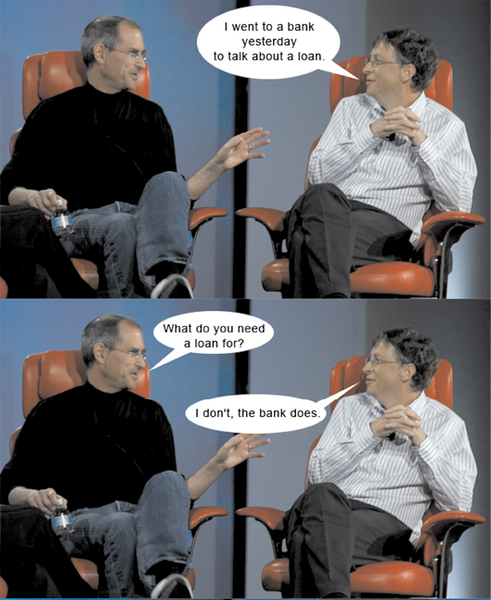
Steve Jobs was the Chairman, CEO60 and co-founder of Apple Inc., a leading manufacturer of electronic devices including the Macintosh Computer (MAC), iPod, iPhone, and the music and video software iTunes. But he is known as a business and sales wizard.
Jobs warmed up the idea to create “blue boxes” and sell them to people wishing to make free long distance phone calls and convinced Wozniak to go into business with him.
He continued to work with Wozniak on other projects and finally convinced him to market a computer Wozniak had built for himself. On April 1, 1976, Apple Inc.61 was born. Although the business started with printed circuit boards62, Steve Wozniak and Steve Jobs eventually created their first personal computer, the Apple I, and sold it for $666.66. They later followed it with the Apple II, a large success for their business.
As the company grew, so did its merchandise and the hugely successful Macintosh was introduced to the public in 1984 and became the first personal computer with a graphical user interface (GUI) through which individuals could interact with the items on the screen. As Apple grew even more, Jobs experienced tension with the board63 and the struggles led to Jobs leaving Apple in May of 1985.
Steve Jobs went on to create the company called NeXT in 1986. Although it began as a company designed around aesthetic interpersonal computing, it later focused more on software development. NeXT ended up playing a major role in the development of e-mail and the World Wide Web.
Apple bought NeXT in 1996 and reinstated64 Jobs as the Chief Executive Officer. He is well known for his work ethic as well as his humorous temper, he consistently helped to grow Apple from a company bordering on bankruptcy in the 1990s to a very successful company today.
William Henry “Bill” Gates III (born October 28, 1955) is an American business magnate, investor, philanthropist, and author. Microsoft is the software company he founded with Paul Allen. He is consistently ranked among the world’s wealthiest people. During his career at Microsoft, Gates held the positions of CEO and chief software architect, and remains the largest individual shareholder, with 6.4 percent of the common stock. He has also authored or co-authored several books.
Gates is one of the best-known entrepreneurs of the personal computer revolution. In the later stages of his career, Gates has pursued a number of philanthropic endeavors65, donating large amounts of money to various charitable organizations and scientific research programs.
Gates stepped down as chief executive officer of Microsoft in January 2000. He remained as chairman and created the position of chief software
architect. In June 2006, Gates announced that he would be transitioning from full-time work at Microsoft to part-time work, and full-time work at the Bill & Melinda Gates Foundation. Gates’ last full-time day at Microsoft was June 27, 2008. He remains at Microsoft as non-executive chairman.
Sir Maurice Vincent Wilkes (26 June 1913 – 29 November 2010) – without doubt one of the foremost pioneers of computing. He was a brilliant British computer scientist and winner of the 1967 Turing Award66. In a remarkably long and distinguished career, he built the EDSAC, the world’s first electronic stored-program computer in 1949 to go into regular service. He is also credited with originating the fundamental software concepts such a microprogramming (1951), bit-sliced architectures, local area networks, macros, symbolic labels and many, many other things.
He served the international computing community with distinction and gained many honors.
Vannevar Bush (March 11, 1890 – June 28, 1974) was an American engineer and science administrator known for his work on analog computing, the idea of the memex, an adjustable microfilm viewer which is somewhat analogous to the structure of the World Wide Web. More specifically, the memex worked as a memory bank to organize and retrieve data. As Director of the Office of Scientific Research and Development, Bush coordinated the activities of some six thousand leading American scientists in the application of science to warfare.
Bush was a well-known policymaker and public intellectual during World War II and the ensuing Cold War67, and was in effect the first presidential science advisor.
Paul Marie Ghislain Otlet (23 August 1868 – 10 December 1944) is one of several people who have been considered the father of information science. Otlet created the Universal Decimal Classification, one of the most prominent examples of faceted classification. Otlet was responsible for the widespread adoption of the standard American 3×5 inch index card in Europe used until recently in most library catalogs around the world. Otlet wrote numerous essays on how to collect and organize the world’s knowledge.
Otlet was the most central figure in the development of Documentation. He struggled tirelessly for decades with the most important technical, theoretical, and organizational aspects of a problem, which is central to mankind: How to make recorded knowledge available to those who need it. He thought deeply and wrote endlessly as he designed, developed, and initiated ambitious solutions at his Institute in Brussels.
In his Traité de Documentation, Otlet speculated68 imaginatively about online communications, text-voice conversion and what is needed in computer work stations, though of course he does not use this terminology.
Sergey Alexeyevich Lebedev (November 2, 1902 – 1974) was a Soviet scientist in the fields of electrical engineering and computer science, and designer of the first Soviet computers.
Lebedev was born in Nizhny Novgorod, Russia. He graduated from Moscow Highest Technical School in 1928. From then until 1946 he worked at All-Union Electrotechnical Institute (formerly a division of MSTU) in Moscow and Kiev. In 1939 he was awarded the degree of Doctor of Sciences for the development of the theory of “artificial stability” of electrical systems.
During World War II, Lebedev worked in the field of control automation of complex systems. His group designed a weapon-aiming stabilization system for tanks and an automatic guidance system for airborne missiles69. To perform these tasks Lebedev developed an analog computer system to solve ordinary differential equations.
In 1948 Lebedev learned from foreign magazines that scientists in western countries were working on the design of electronic computers, although the details were secret. In the autumn of the same year he decided to focus the work of his laboratory on computer design. Lebedev’s first computer, BESM-1, was completed by the end of 1951. In April 1953 the State commission accepted the BESM-1 as operational, but it did not go into series production because of opposition from the Ministry of Machine and Instrument Building, which had developed its own weaker and less reliable machine.
Lebedev then began development of a new, more powerful computer, the M-20, the number denoting its expected processing speed of twenty thousand operations per second. In 1958 the machine was accepted as operational and put into series production. Simultaneously the BESM-2, a development of the BESM-1, went into series production. Though the BESM-2 was slower than the M-20, it was more reliable. It was used to calculate satellite orbits and the trajectory of the first rocket to reach the surface of the Moon. Lebedev and his team developed several more computers, notably the BESM-6, which was in production for 17 years.
In 1952, Lebedev became a professor at the Moscow Institute of Physics and Technology. From 1953 until his death he was the director of what is now called the Institute of Precision Mechanics and Computer Engineering.
In 1996 the IEEE Computer Society recognized Sergei Lebedev with a Computer Pioneer Award for his work in the field of computer design and his founding of the Soviet computer industry.
Notes to the text:
60. CEO – Chief Executive Officer – главный исполнительный директор, высшее должностное лицо компании;
61. Apple Inc. – an American corporation that designs and sells computer electronics, computer software and personal computers;
62. printed circuit boards – печатные платы;
63. tension with the board – напряжённость (расхождение во взглядах, разногласия) с советом, правлением;
64. reinstate – восстанавливать в должности (Приставка re- к глаголу instate (вводить на должность) прибавляется для обозначения повторного действия);
65. pursued a number of philanthropic endeavors – предпринял ряд благотворительных начинаний;
66. Turing Award – премия Тьюринга, самая престижная премия в информатике, вручаемая Ассоциацией вычислительной техники за выдающийся научно-технический вклад в этой области. Премия учреждена Ассоциацией вычислительной техники в честь выдающегося английского учёного Алана Тьюринга, получившего первые глубокие результаты относительно вычислимости задолго до появления первых электронных вычислительных машин. В сфере информационных технологий премия Тьюринга имеет статус, аналогичный Нобелевской премии в академических науках. Впервые Премия Тьюринга была присуждена в 1966 году Алану Перлису за развитие технологии создания компиляторов.
67. Cold War – Холодная война – глобальная геополитическая, военная, экономическая и информационная конфронтация между СССР и его союзниками, с одной стороны, и США и их союзниками – с другой, длившаяся с 1946 по 1991 год.
68. speculate – размышлять;
69. airborne missiles – воздушные ракеты.
Tasks for the text:
1. Put the necessary word(words) into the sentence:
1) Lebedev graduated from … in 1928.
2) During World War II, Lebedev worked … control automation of complex systems.
3) Otlet was awarded … for the development of the theory of “artificial stability” of electrical systems.
4) Bill Gates is … among the world’s wealthiest people.
5) … was a brilliant British computer scientist and winner of the 1967 Turing Award.
6) Steve Jobs convinced … to market a computer he had built
for himself.
7) Gates has pursued … donating large amounts of money to various charitable organizations and scientific research programs.
2. Complete the sentences using words from the text or words with the appropriate meaning:
1) Otlet wrote …
2) Otlet created …
3) Steve Jobs is well known for …
4) Lebedev developed an analog computer system to ...
5) Bill Gates announced that he would be transitioning from full-time work at Microsoft …
6) Otlet struggled tirelessly for decades with....
7) Lebedev was awarded the degree of Doctor of Sciences for ...
8) Steve Wozniak and Steve Jobs sold their first personal computer, the Apple I, for …
3. Match the pictures of the following persons in accordance with their names:
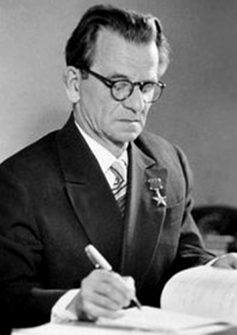 Picture 1. Sergey Alexeyevich Lebedev
Picture 1. Sergey Alexeyevich Lebedev
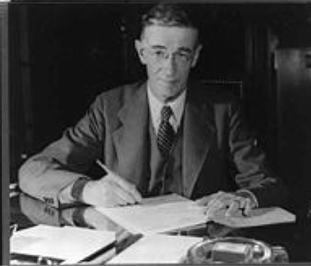 Picture 2. Paul Marie Ghislain Otlet
Picture 2. Paul Marie Ghislain Otlet
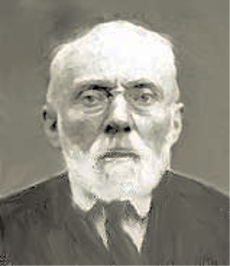 Picture 3. William Henry “Bill” Gates III
Picture 3. William Henry “Bill” Gates III
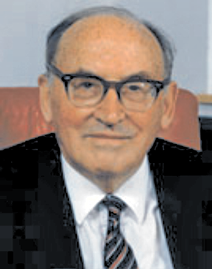 Picture 4. Steve Jobs
Picture 4. Steve Jobs
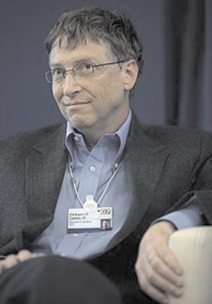 Picture 5. Vannevar Bush
Picture 5. Vannevar Bush
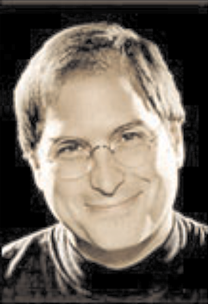 Picture 6. Sir Maurice Vincent Wilkes
Picture 6. Sir Maurice Vincent Wilkes
4. Match the words from the text denoting the occupation with their definitions:
|
Number |
Concept |
Definition |
|
1. |
philanthropist |
an individual who builds capital through risk and initiative |
|
2. |
wizard |
an expert who gives professional consultations |
|
3. |
entrepreneur |
someone who donates his or her time, money and/or reputation to charitable causes |
|
4. |
chairman |
a person with a high degree of knowledge or skill in a particular field |
|
5. |
administrator |
a person who manages or has a talent for managing |
|
6. |
policymaker |
a person who is first among the earliest in any field of inquiry, enterprise, or progress |
|
7. |
pioneer |
someone who sets the plan pursued by a government or business etc. |
|
8. |
advisor |
a person who presides at a meeting or heads a committee, board, etc. |
5. Write the events, which happened in the sphere of information technology for the last 10 years in the chronological order. Use Past Simple to express things happened.
6. Complete the table. Use additional information when necessary:
|
Number |
Popular person in the field of computer technology |
His (her) achievement |
|
1 |
Sir Maurice Vincent Wilkes |
………………………………. |
|
2 |
Steve Jobs |
promoted products of Apple Inc. |
|
3 |
Vannevar Bush |
……………………………. |
|
4 |
Bill Gates |
…………………………… |
|
5 |
Sergey A. Lebedev |
designed the first Soviet computers |
|
6 |
Paul Marie Ghislain Otlet |
……………………………….. |
|
7 |
Charles Babbage |
………………………… |
|
8 |
………………….. |
……………………………. |
7. Choose an article from a magazine or a newspaper about a well-known person distinguished in IT. Write a short annotation for it using expressions below.
|
The title of the article |
The article is headlined… The headline of the article I have read is… |
|
The author of the article, where and when the article was published |
The author of the article is… The author’s name is ... Unfortunately the author’s name is not mentioned ... The article is written by… It was published in … (on the Internet). It is a newspaper (scientific) article (published on March 10, 2012 / in 2010). |
|
The main idea of the article |
The main idea of the article is… The article is about… The article is devoted to… The article deals (is concerned) with… The article touches upon the issue of… The purpose of the article is to give the reader some information on… The aim of the article is to provide the reader with some material on… |
|
The contents of the article: some facts, names, figures |
The author starts by telling (the reader) that… The author (of the article) writes (reports, states, stresses, thinks, notes, considers, believes, analyses, points out, says, describes) that… / draws reader’s attention to... Much attention is given to… According to the article… The article goes on to say that… It is reported (shown, stressed) that … It is spoken in detail about… From what the author says it becomes clear that… The article gives a detailed analysis of… |
|
Conclusion |
In conclusion the author writes (reports, states, stresses, thinks, notes, considers, believes, analyses, points out, says, describes) that… / draws reader’s attention to... The author comes to the conclusion that… The following conclusions are drawn: … |
|
Your opinion |
I found the article (rather) interesting (important, useful) as / because… I think / In my opinion the article is (rather) interesting (important, useful) as / because… I found the article too hard to understand / rather boring as / because |
Example:
1. The headline of the article is “Tim Cook”. It comes up from the magazine “PC World”. It is dated 2013. The article is placed on page 9. The author of the article is Robert Brown.
2. This issue refers to the field of IT and concerns some points of Tim Cook’s biography.
3. The central part of the article is the personality of Tim Cook.
4. According to the article he is Steve Jobs’ follower and successor and he has been holding an appointment of the CEO of Apple since August 2011.
5. I found the article very interesting.
